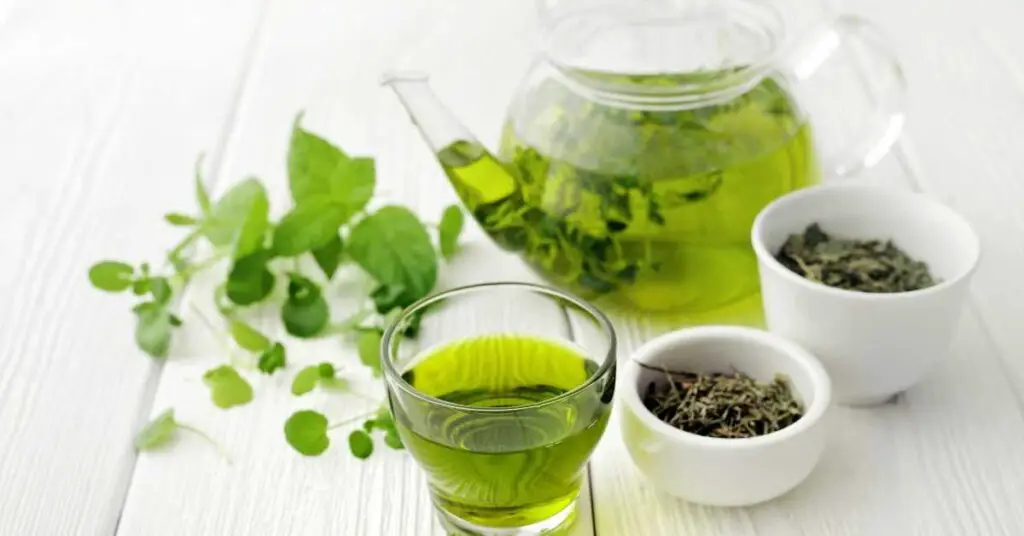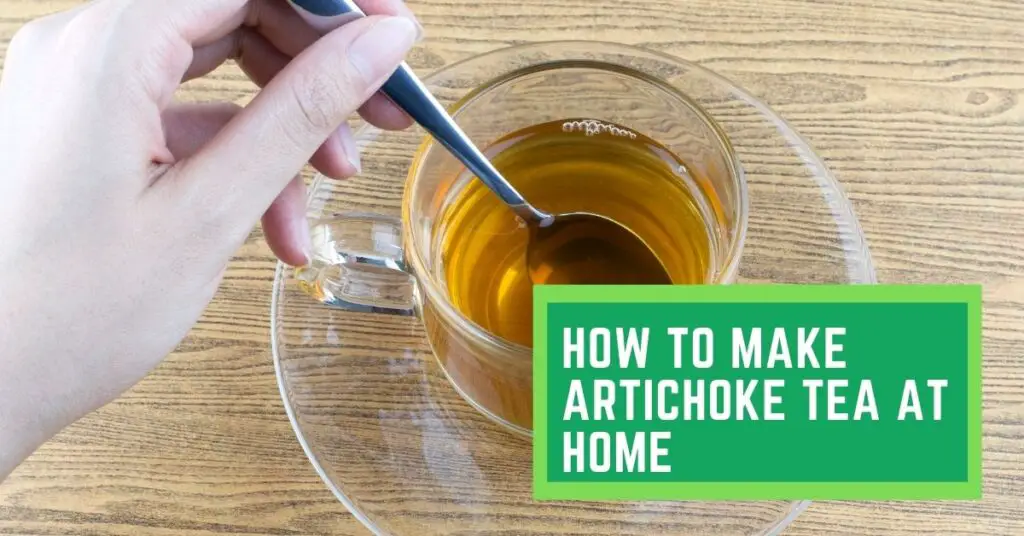Welcome to the aromatic world of home tea gardening, where the soothing ritual of brewing your own cuppa takes on a whole new level of satisfaction. If you’ve ever dreamed of cultivating your own personal tea haven, you’re in for a treat.
In this guide, we’ll embark on a journey through the verdant landscape of growing your own tea right in the comfort of your home.
Also read: The passionate debates and preferences: Loose leaf vs. tea bags.

Understanding the Benefits
Picture this: the sun gently kissing your backyard, a light breeze carrying the fragrance of your flourishing tea plants. Beyond the obvious perks of having a fragrant, green corner in your living space, cultivating your tea garden comes with a bundle of benefits.
A Symphony for the Senses
Imagine the delight of plucking fresh tea leaves and immersing yourself in the rich aromas as you brew your morning tea. Homegrown tea is a sensory symphony, a dance of flavors and fragrances that store-bought blends can rarely replicate.
Health on Your Doorstep
Beyond the pleasure of a homegrown brew, you’re tapping into a wellness hub. You have control over pesticides, chemicals, and the freshness of your tea leaves, ensuring a cuppa brimming with health benefits.
Eco-Friendly Sips
Your home tea garden is your contribution to a greener planet. By reducing your reliance on store-bought tea, you’re cutting down on the carbon footprint associated with packaging and transportation.
Why Start Your Own Tea Garden?
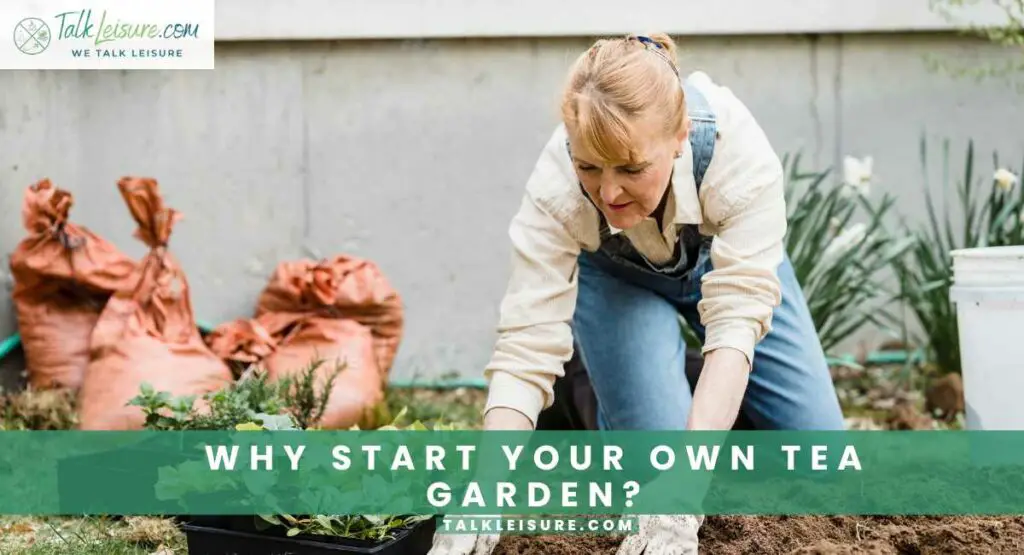
Now, you might be thinking, “Why not just grab a box from the store?” Excellent question. While store-bought tea serves its purpose, there’s an irreplaceable joy in growing, harvesting, and brewing your own. Here are a few compelling reasons to dive into the world of home tea gardens:
Tailored to Your Taste
Are you tired of the same old blends? When you grow your own tea, you’re the master blender. Customize your brews to match your taste preferences, experiment with unique flavors, and share your creations with friends.
Gardening Therapy
Gardening is not just a hobby; it’s a therapeutic journey. The act of nurturing plants, watching them thrive under your care, and reaping the rewards is a mindful practice that brings peace to your daily life.
A Sustainable Sip
In a world increasingly conscious of sustainability, growing your own tea is a small but impactful step. You reduce your reliance on mass-produced, often environmentally taxing, tea varieties and embrace a more sustainable, eco-friendly lifestyle.
So, if the idea of sipping a cup of tea made from leaves you’ve lovingly nurtured appeals to you, buckle up. We’re about to embark on a delightful adventure into the realm of home tea gardening.
From choosing the right plants to savoring the final brew, this guide has got you covered. Let’s turn that green dream of yours into a reality!
Choosing the Right Tea Plants
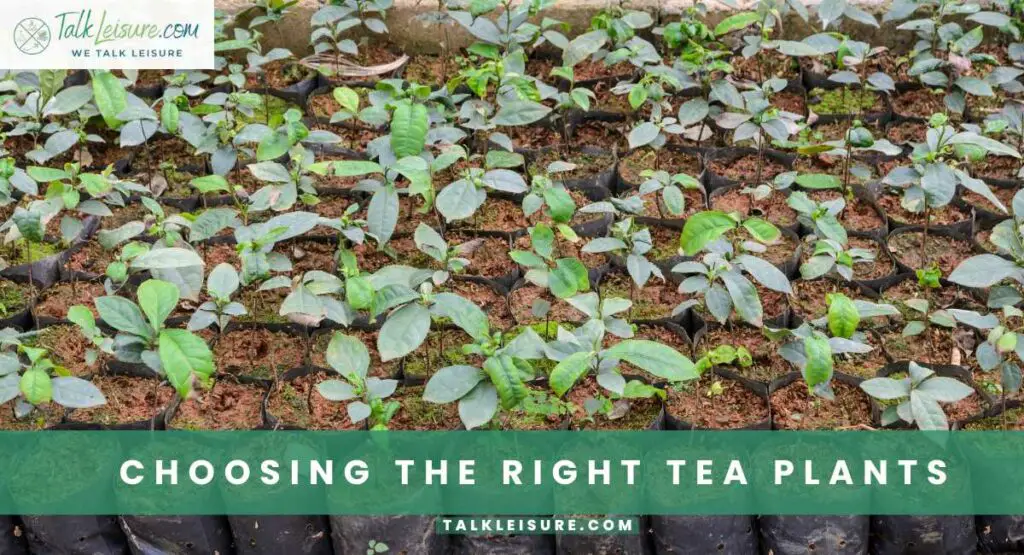
Now that you’ve caught the gardening bug, it’s time to dive into the heart of your tea garden – the plants themselves. But hold on, we’re not talking about a one-size-fits-all situation. Your tea garden should be as unique as you are. Let’s explore the key factors in selecting the perfect tea plants for your home oasis.
Types of Tea Plants Suitable for Home Gardens
Tea, as we know it, isn’t just a singular entity. It’s a diverse family, each member bringing its own character to the brew. Here are some tea plants well-suited for home gardens:
Camellia sinensis (Tea Plant)
The holy grail of tea plants, Camellia sinensis is your gateway to a world of tea diversity. This plant gives birth to white, green, oolong, and black teas. Compact and amenable to pruning, it’s a perfect fit for both gardens and containers.
Camellia assamica (Assam Tea)
If you’re a fan of robust, malty black teas, the Assam tea plant is your go-to. It thrives in warmer climates and adds a bold, distinctive flavor to your homemade blends.
Camellia japonica (Japanese Tea Plant)
Known for its ornamental beauty, the Japanese tea plant isn’t just eye candy. It can be a delightful addition to your garden, offering leaves suitable for green tea.
Herbal Tea Varieties
Expand your horizons beyond traditional tea plants. Herbs like mint, chamomile, and lavender can be wonderful additions, adding unique flavors and aromas to your tea garden.
As you choose your tea plants, consider the space you have, the flavors you love, and the level of care each variety demands. Think of it as assembling a cast of characters for your own tea saga.
Considerations for Your Climate Zone
Tea plants, like any divas, have preferences. They might love the limelight but not the scorching heat or biting cold. Before you start planting, it’s crucial to know your garden’s climate zone. Here’s a quick guide:
Temperate Climates
If you’re blessed with mild temperatures, the world of tea is your oyster. Camellia sinensis thrives in these conditions, and you can experiment with various tea types.
Tropical Climates
In warmer zones, consider the robust Assam tea plant. Its love for heat and humidity makes it a star performer in tropical climates.
Container Gardening for All Climates
Don’t be disheartened if your climate isn’t tea-plant-friendly. Many tea varieties, especially Camellia sinensis, adapt well to container gardening. This opens the door for tea enthusiasts in all corners of the world to join the garden party.
As you embark on this leafy journey, remember, the key is to find the tea plants that resonate with you and thrive in your unique gardening environment. It’s not just about growing tea; it’s about creating a personalized symphony of flavors in your own backyard. Get ready to let those tea leaves dance!
Selecting the Ideal Location

Now that you’ve chosen your tea companions, it’s time to find them the perfect stage to shine. Location, as they say, is everything. Whether it’s the gentle warmth of the morning sun or the richness of the soil beneath, each element plays a crucial role in the success of your tea garden. Let’s explore how to set the stage for your tea plants to flourish.
Sunlight Requirements
Tea plants, much like sunbathers on a beach, have their preferences when it comes to sunlight. In the world of tea gardening, sunlight is the secret ingredient that brings out the best flavors. Here’s your sunlight cheat sheet:
Full Sun Exposure:
Most tea plants, especially Camellia sinensis, thrive in full sunlight. Aim for at least 6 hours of direct sunlight daily. If you can offer them a sun-soaked spot, you’ll be rewarded with vibrant, healthy plants and flavorful tea leaves.
Partial Shade Considerations
If you’re in a scorching climate, a bit of afternoon shade can be a boon. Some tea plants, especially in warmer regions, appreciate a break from the intense midday sun.
Remember, sunlight isn’t just about quantity; it’s also about quality. Observing your garden’s sunlight patterns throughout the day will help you find the sweet spot for your tea plants.
Soil Quality and pH Levels
Tea plants are like gourmet chefs – they demand the finest ingredients. In this case, the soil is their kitchen. Here’s what you need to know about creating the perfect soil recipe for your tea garden:
Well-Draining Soil
Tea plants despise soggy feet. Ensure your soil drains well to prevent waterlogging, which can lead to root rot. Sandy loam or loamy soil is an excellent choice.
Acidic Soil pH
Tea plants thrive in slightly acidic soil with a pH range of 6 to 6.5. You can test your soil’s pH using a simple kit available at garden centers. If needed, amendments like sulfur can be added to adjust the pH.
Nutrient-Rich Goodies
Enrich your soil with organic matter like compost. This not only provides essential nutrients but also improves soil structure, promoting a healthy root system.
Container Gardening vs. In-Ground Planting
The age-old debate: to plant in the ground or embrace the versatility of containers? Let’s weigh the pros and cons:
In-Ground Planting
If you have the space and the right soil, planting directly in the ground can offer a stable environment for your tea plants. It allows for natural root expansion and a more sustainable ecosystem.
Container Gardening
For those with limited space or challenging soil conditions, containers are the answer. They offer mobility, allowing you to chase the sun or shield your plants from harsh weather. Container gardening is also a savior for urban tea enthusiasts.
Consider the specifics of your gardening space, your climate, and your lifestyle when deciding between in-ground and container planting. Whichever path you choose, remember that a happy tea plant is a generous tea plant.
As you set the scene for your tea garden, envision it as a performance space where every element harmonizes to create a masterpiece. The right location is not just a backdrop; it’s a supporting actor in the tale of your flourishing tea garden. Let the show begin!
Essential Tools and Supplies

Now that you’ve selected the prime spot for your tea garden, it’s time to equip yourself with the tools and supplies that will turn your gardening venture into a breeze. From the right spade to the golden nectar of fertilizers, each item plays a crucial role in nurturing your tea plants. Let’s dive into the toolkit of a successful tea gardener.
Must-Have Gardening Equipment
Just as a painter relies on brushes and a musician on instruments, a tea gardener needs the right tools. Here’s a rundown of the must-haves:
Pruning Shears
Your green companions will appreciate a trim now and then. Invest in a good pair of pruning shears to keep your tea plants in shape and encourage healthy growth.
Garden Spade
The foundation of every garden, a sturdy spade is your partner in soil preparation, planting, and general garden maintenance.
Watering Can or Hose
Tea plants, like any living thing, need hydration. Whether it’s a charming watering can or a practical hose, ensure you can deliver a gentle, consistent flow of water to your plants.
Soil pH Tester
Keep an eye on your soil’s pH levels with a simple tester. This tool ensures your tea plants are performing in the optimal acidity range.
Mulching Materials
Mulch is the unsung hero of gardens. It retains moisture, regulates soil temperature, and suppresses weeds. Organic mulches like straw or wood chips are excellent choices.
High-Quality Soil and Fertilizers
Just as a gourmet chef sources the finest ingredients, your tea plants deserve top-notch soil and nourishment. Here’s how to pamper them:
Quality Potting Mix
If you’re going the container gardening route, invest in a high-quality potting mix. Look for well-draining blends with added organic matter.
Organic Fertilizers
Tea plants appreciate a balanced diet. Choose organic fertilizers with a good mix of nitrogen, phosphorus, and potassium. Compost and well-rotted manure are excellent natural options.
Slow-Release Fertilizers
For a steady nutrient supply, consider slow-release fertilizers. They provide a constant stream of nourishment, ensuring your tea plants have a sustained feast.
Proper Watering Techniques
Water, the elixir of life for your tea garden. But beware, too much or too little can upset the delicate balance. Master the art of proper watering:
Consistency is Key
Tea plants prefer consistent moisture. Water deeply but allow the soil to dry slightly between watering sessions. This encourages healthy root development.
Morning Watering
Aim to water your tea garden in the morning. This gives the plants ample time to absorb moisture before the heat of the day, reducing the risk of fungal diseases.
Avoid Waterlogged Soil
Tea plants dislike soggy roots. Ensure proper drainage to prevent waterlogging, especially in container gardens.
Armed with these essential tools and supplies, you’re ready to embark on the hands-on journey of tea gardening. Think of yourself as a tea maestro, orchestrating a symphony of growth and flavor. The right equipment and nourishment lay the groundwork for a flourishing tea garden that will reward you with bountiful harvests and aromatic sips. Let the gardening symphony begin!
Planning Your Tea Garden Layout

Now that your gardening arsenal is prepped, it’s time to put on your designer hat and plan the layout of your tea haven. Think of it as choreographing a dance where each plant has its role, creating a harmonious and thriving ecosystem. Let’s delve into the art of tea garden layout.
Companion Planting for Tea
In the intricate dance of a tea garden, companion planting is your secret weapon. Certain plants can act as supportive partners, enhancing the growth and flavor of your tea plants. Consider these companion plants for a symphony of flavors:
Mint
Planting mint near your tea can deter pests and adds a refreshing twist to your tea blends.
Chamomile
Known for its calming properties, chamomile is a friendly neighbor that complements the lively notes of your tea.
Lavender
Besides its aromatic allure, lavender can help repel insects that might bother your tea plants.
Nasturtium
These vibrant flowers not only add a pop of color but can also act as a trap crop, luring away pests from your precious tea leaves.
Arranging Plants for Optimal Growth
In the world of tea gardening, organization is the key to a flourishing garden. Consider these tips for arranging your tea plants for optimal growth:
Spacing Matters
Give your tea plants room to spread their roots. Proper spacing helps prevent competition for nutrients and sunlight.
Sun-Loving Strategy
Arrange your tea plants to make the most of sunlight. Taller plants should be to the north or west of shorter ones to avoid shading.
Windbreak Considerations
If your garden is prone to strong winds, use taller companion plants or structures to create a windbreak, protecting your delicate tea leaves.
Grouping by Type
Consider grouping tea plants of the same type together. This not only makes harvesting more efficient but also facilitates targeted care for each variety.
As you lay out the canvas of your tea garden, envision the growth patterns, flavors, and interactions between your chosen plants. It’s not just about where they stand; it’s about how they dance together in the orchestra of your garden.
Your tea garden layout is the blueprint for a thriving ecosystem where each plant contributes to the harmony of the whole. With companion plants as your allies and strategic arrangement as your guide, you’re ready to create a garden that not only delights the eyes but also yields flavorful and aromatic teas. Let the choreography of growth commence!
Starting from Seeds vs. Seedlings
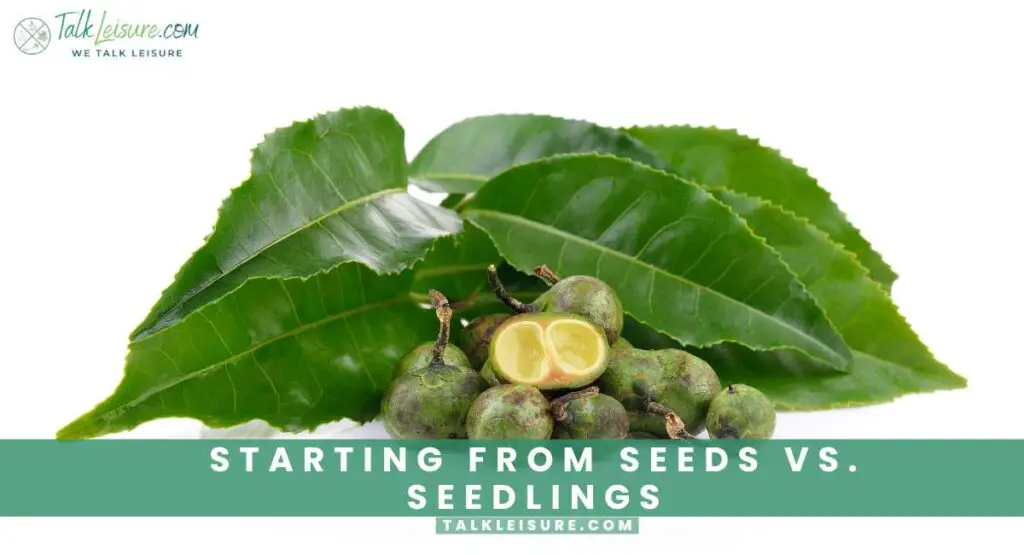
Now that your tea garden layout is mapped out, it’s time to decide how you want to introduce your tea plants to the stage. Will they make a grand entrance as seeds, patiently waiting to sprout, or will you bring in the already promising seedlings? Let’s explore the art of starting your tea garden from the very beginning.
Germinating Tea Seeds
Starting your tea garden from seeds is a journey that begins with a promise – the promise of new life and the anticipation of future sips. Here’s how to germinate tea seeds and kickstart your botanical adventure:
Seed Selection
Choose high-quality tea seeds from a reputable source. Varieties like Camellia sinensis seeds are often available and can be the start of a diverse tea garden.
Stratification
Some tea seeds benefit from a period of cold stratification to simulate winter conditions. Place them in a sealed plastic bag with a moist medium (like vermiculite) and refrigerate for a few weeks.
Planting the Seeds
Plant your stratified seeds in seed trays or small pots filled with a well-draining potting mix. Bury them just beneath the surface, water gently, and cover with a plastic dome or plastic wrap to create a humid environment.
Warm and Sunny Spot
Place the trays or pots in a warm and sunny location, maintaining consistent moisture. Germination can take several weeks, so be patient as you wait for the first tiny leaves to emerge.
Transplanting Seedlings
If you’re opting for a head start with seedlings, you’re bringing in the green stars ready to take center stage. Here’s how to seamlessly transplant them into your tea garden:
Acclimatization
Before transplanting, acclimate your seedlings to outdoor conditions gradually. Start by placing them in a sheltered spot for a few hours each day, increasing the exposure gradually.
Soil Preparation
Ensure your garden soil or container mix is well-prepared. It should be well-draining and enriched with compost.
Digging and Planting
Dig holes in your garden or prepare the containers for transplanting. Gently remove the seedlings from their pots, keeping the root ball intact. Place them in the holes or containers, filling in with soil around the roots.
Watering and Mulching
Water the transplanted seedlings thoroughly and add a layer of mulch around them. Mulching helps retain moisture and regulates soil temperature, giving your seedlings a cozy new home.
Starting from seeds or opting for seedlings is a decision that shapes the early chapters of your tea garden story. Whether you’re captivated by the magic of sprouting seeds or eager to witness the immediate presence of seedlings, each method has its unique charm.
As you usher in the newest members of your tea garden, remember, you’re not just planting seeds; you’re sowing the foundation for a future of aromatic bliss and verdant beauty. Let the germination commence!
Caring for Your Tea Plants
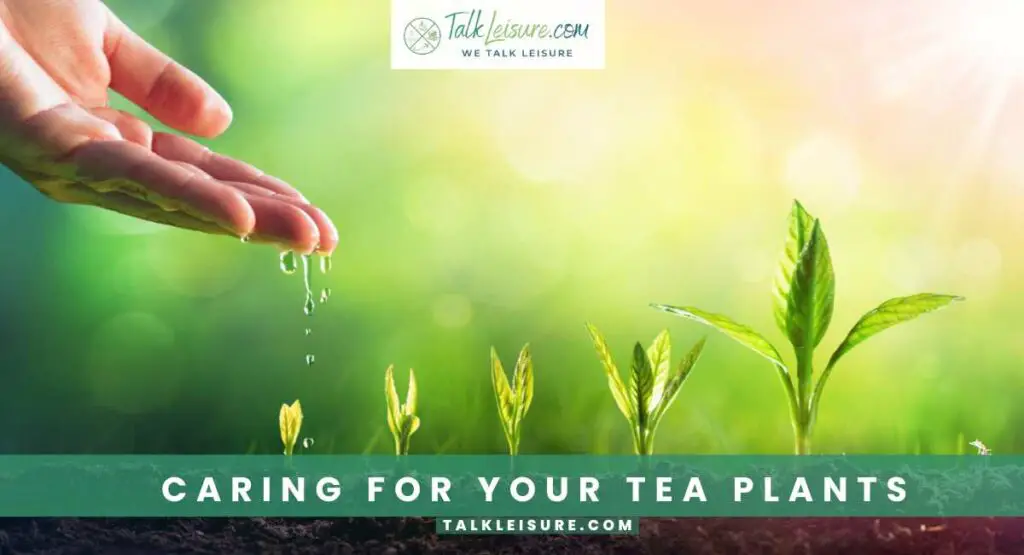
Your tea garden is now a living, breathing entity, and like any masterpiece, it requires care and attention. From the art of pruning to waging war against pesky invaders, and providing the nutritional sustenance your tea plants crave, this section covers the essential aspects of nurturing a thriving tea garden.
Pruning Tips for Tea Plants
Pruning is the dance of shaping and encouraging growth. Mastering this art ensures your tea plants stay healthy, productive, and a visual delight. Here are some pruning tips for your tea garden:
Regular Maintenance
Schedule regular pruning sessions to remove dead or diseased branches. This not only keeps your tea plants tidy but also prevents the spread of pests and diseases.
Encourage Lateral Growth
Prune the top shoots to encourage lateral growth. This helps create a bushier plant, increases air circulation, and makes harvesting easier.
Harvesting Leaves
When harvesting tea leaves, use sharp scissors or pruning shears. Harvest the young, tender leaves at the top, leaving the lower leaves to continue supporting the plant’s growth.
Shape with Purpose
Prune with an eye for shape and structure. Create an open, vase-like form that allows sunlight to penetrate, promoting even growth throughout the plant.
Pest Control Strategies
A flourishing tea garden can sometimes attract uninvited guests. Here’s how to keep pests at bay and protect your precious tea leaves:
Neem Oil
Neem oil is a natural insecticide that can deter pests without harming your plants. Mix with water and apply it to the foliage, especially the undersides of leaves.
Beneficial Insects
Introduce beneficial insects like ladybugs and predatory beetles that feed on common tea pests. They act as a natural pest control squad, maintaining a balance in your garden.
Companion Plants for Pest Control
Some plants, like marigolds and chrysanthemums, emit natural compounds that repel pests. Strategically plant these companions to create a barrier against invaders.
Vigilant Monitoring
Regularly inspect your tea plants for signs of pest infestation. Early detection allows for swift action, preventing the escalation of pest problems.
Fertilization Schedule
Feeding your tea plants is like providing them with a gourmet meal. A well-planned fertilization schedule ensures they get the nutrients they need for robust growth and flavorful leaves:
Spring Feeding
As your tea plants wake up from winter dormancy, provide a balanced, slow-release fertilizer. This kickstarts the growing season with a burst of nutrients.
Midsummer Boost
Around midsummer, when your tea plants are in full swing, offer a supplemental feeding. This helps sustain their energy and supports continuous leaf production.
Fall Prep
As fall approaches, shift your focus to preparing your tea plants for the dormant season. A low-nitrogen fertilizer can help strengthen roots and prepare the plants for winter.
Organic Amendments
Consider incorporating organic amendments like compost or well-rotted manure. These not only provide essential nutrients but also improve soil structure over time.
Caring for your tea plants is a dynamic process that involves a combination of art and science. From shaping their growth to protecting them from invaders and offering a carefully timed feast, your care ensures a bountiful harvest and a garden that flourishes season after season.
As you tend to your tea plants, remember, each snip, spray, and feeding is a gesture of love for the aromatic journey that awaits in your teacup. Happy gardening!
Harvesting and Processing Your Own Tea
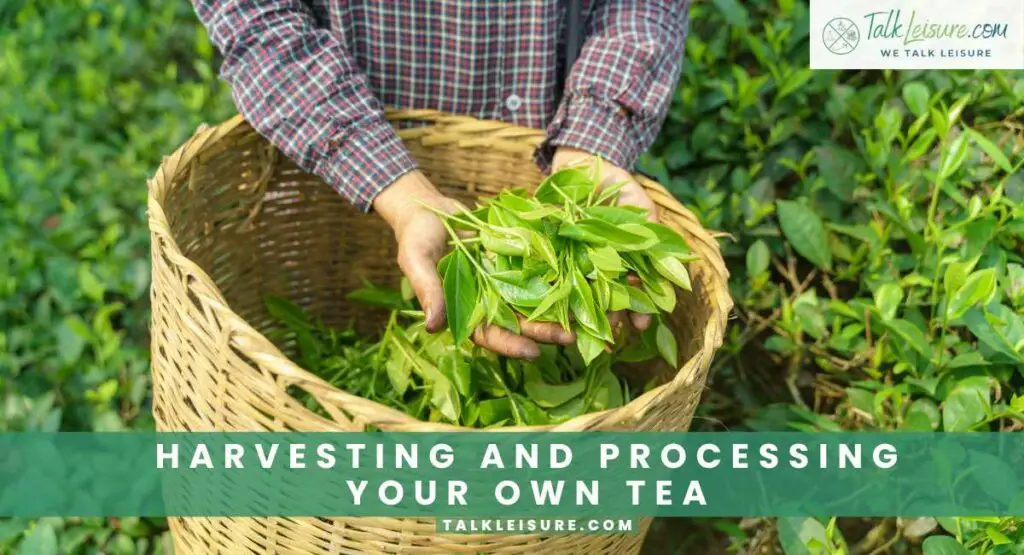
The moment you’ve been patiently waiting for has arrived – it’s time to reap the rewards of your dedication and witness the transformation of your tea garden into a cup of liquid bliss. In this section, we’ll explore the art of harvesting tea leaves and the meticulous process of turning them into a fragrant brew.
When and How to Harvest Tea Leaves
Harvesting tea is a delicate choreography, a dance between timing and technique. Follow these guidelines to ensure your tea leaves are plucked at the peak of perfection:
Timing is Everything
Harvest your tea leaves in the morning when the essential oils are at their peak. This is when the flavors and aromas are most concentrated.
Choose the Right Leaves
Focus on harvesting the young, tender leaves at the top of the plant. These contain the highest concentration of flavor compounds.
Regular Harvesting
For a continuous supply of fresh tea, practice regular harvesting. Depending on the type of tea you’re cultivating, you might harvest every few weeks during the growing season.
Hand Plucking
The traditional and most gentle method is hand plucking. Use your fingers or small scissors to snip the leaves, being careful not to damage the remaining plant.
Two-Leaves-and-a-Bud Rule
Adhere to the “two leaves and-a-bud” rule. Harvest the top two leaves and the unopened leaf bud, as these are the prime components for high-quality tea.
Drying and Curing Methods
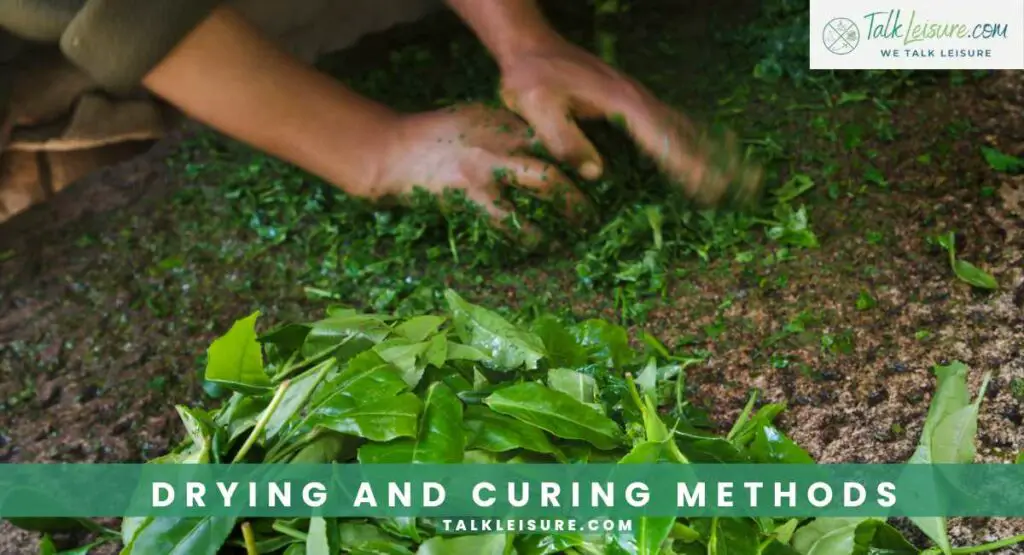
Harvesting is just the beginning; the true magic happens during the drying and curing process. Here’s how to elevate your freshly plucked leaves into a tea masterpiece:
Withering
Spread the freshly harvested leaves in a single layer to wither. This reduces moisture content and initiates the enzymatic processes that contribute to flavor development.
Rolling
Gently roll the withered leaves to break down cell walls and release the essential oils. This step is crucial for developing the characteristic flavors of different tea types.
Oxidation (for Oolong and Black Teas)
Allow the rolled leaves to undergo controlled oxidation. This is where the magic of transforming green leaves into oolong or black tea happens. Monitor the oxidation process carefully to achieve the desired flavor profile.
Drying
Once the desired level of oxidation is reached, dry the leaves to halt the enzymatic reactions. This can be done through various methods, including air drying, pan firing, or using specialized drying machines.
Curing (for Green Teas)
If you’re crafting green tea, skip the oxidation step and proceed directly to drying. Curing green tea involves heat treatment to preserve the natural green color and fresh, grassy flavors.
Harvesting and processing your own tea is an art that blends nature’s gifts with human craftsmanship. The flavor nuances, aroma complexities, and mouthfeel of the final brew are all shaped during these crucial steps.
As you embark on this final phase of your tea gardening journey, savor the anticipation of tasting the fruits of your labor – a cup of tea that carries the essence of your own garden. Happy harvesting!
Troubleshooting Common Issues
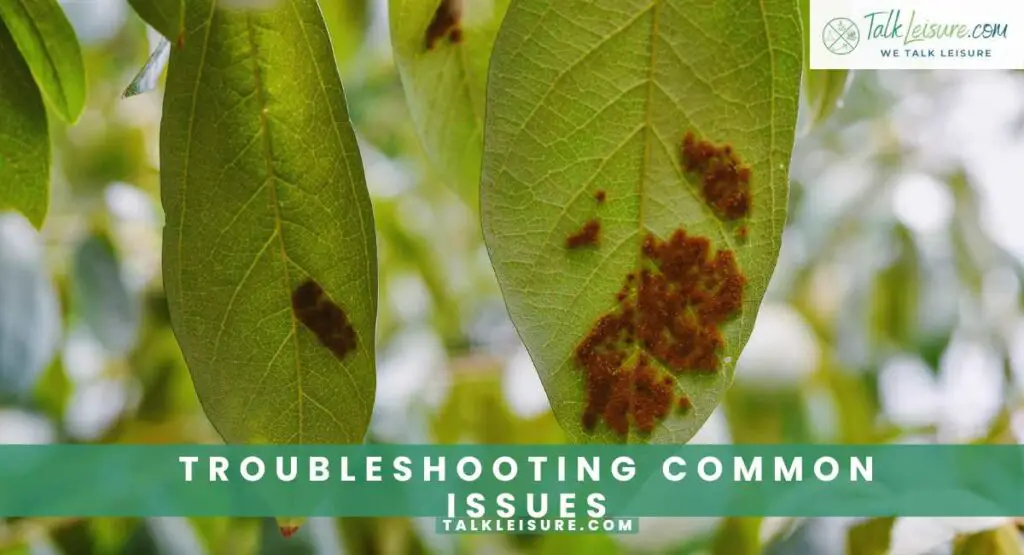
In the intricate world of tea gardening, challenges may arise, testing the resilience of your green companions. Fear not; this troubleshooting guide is your ally, offering solutions to common issues that may threaten the well-being of your tea garden.
Dealing with Pests and Diseases
Even the most meticulously tended gardens may face unwelcome visitors. Here’s how to combat common pests and diseases that might attempt to infiltrate your tea haven:
Aphids and Mites
Blast them away with a strong jet of water or introduce natural predators like ladybugs. Neem oil can also be effective in deterring these tiny invaders.
Caterpillars and Worms
Handpick larger pests and introduce natural predators like birds or beneficial insects. Bacillus thuringiensis (Bt) is an organic pesticide effective against caterpillars.
Fungal Diseases
Improve air circulation by pruning and thinning plants. Apply copper-based fungicides for preventive measures or neem oil for control.
Root Rot
Ensure well-draining soil to prevent waterlogging. Adjust watering practices, and treat with fungicides containing beneficial bacteria or fungi.
Powdery Mildew
Keep foliage dry by watering at the base of the plant. Apply neem oil or sulfur-based fungicides for control.
Addressing Soil and Nutrient Problems
The health of your tea plants begins with the soil beneath their roots. Here’s how to troubleshoot common soil and nutrient issues:
Nutrient Deficiency
Identify specific nutrient deficiencies through leaf discoloration or stunted growth. Adjust your fertilization schedule, incorporating the lacking nutrients.
Soil pH Imbalance
Test your soil regularly and amend pH as needed. Add lime to raise pH or sulfur to lower it, ensuring your tea plants perform in the optimal range.
Compacted Soil
Aerating the soil and adding organic matter can improve soil structure, promoting better water drainage and root development.
Excessive Watering
Adjust your watering schedule to prevent waterlogging. Ensure proper drainage, especially in container gardens, to avoid root rot.
Poor Soil Texture
Sandy soil drains quickly but may lack nutrients, while clayey soil retains water but can be prone to compaction. Amend your soil with organic matter to improve texture.
Troubleshooting soil and nutrient issues requires a keen observation of your tea garden and a thoughtful approach to corrective measures. By addressing these challenges promptly and with care, you’ll fortify the foundation of your tea plants, ensuring they thrive in a balanced and nourishing environment.
Remember, each challenge is an opportunity to deepen your understanding of your tea garden and refine your skills as a caretaker. As you navigate these troubleshooting techniques, you’ll become a seasoned tea gardener, adept at maintaining the health and vitality of your verdant sanctuary. Happy gardening!
Conclusion
Embarking on the journey to cultivate your tea garden has been a rewarding odyssey, where each leaf tells a story of growth, flavor, and dedication. Reflect on the moments spent nurturing your plants, from tender seedlings to rich harvests. As your tea garden flourishes, embrace the ethos of sustainable and enjoyable gardening.
Let this not just be a guide but an invitation to a lifestyle that harmonizes with nature. Encourage others to join this green revolution, sipping on the joy of homegrown teas and contributing to a more sustainable world. Your tea garden is not just a plot; it’s a legacy, a testament to the art and joy of cultivating nature’s finest. Cheers to your thriving tea journey!
Frequently Asked Questions
- How do you dry tea leaves?
To dry tea leaves spread freshly harvested leaves in a single layer for withering, reducing moisture. Gently roll the leaves to release essential oils, then air-dry or use specialized drying methods. For green tea, skip oxidation, proceeding directly to drying. The meticulous drying process preserves flavors, completing the journey from garden to teacup with aromatic finesse.
- Can I reuse tea leaves?
Yes, you can reuse tea leaves for multiple infusions, depending on the type of tea. High-quality loose-leaf teas, such as oolong and some green teas, can be steeped multiple times. Each infusion may offer nuanced flavors. Experiment with steeping times to find the optimal balance. However, it’s essential to note that not all teas are suitable for multiple infusions, and the flavor may diminish with each subsequent steeping.
- Can you put tea in the fridge?
Yes, you can put tea in the fridge. Storing brewed tea in the refrigerator is a common practice, especially for iced tea or if you want to keep a batch of tea cold for later consumption. However, it’s important to cover or seal the container to prevent the absorption of odors from the fridge.
Additionally, if you’re refrigerating hot tea, allow it to cool to room temperature before placing it in the fridge to avoid temperature fluctuations that may impact the flavor. Cold brewing is another method where tea leaves are steeped in cold water in the fridge for an extended period.







